|
|
| Several RC magazines around the world have asked us to write a monthly column. With the kind permission we will re-publish the column at our web site too so all of the XRAY fans can read the latest news and behind the scenes information. Enjoy. |
|
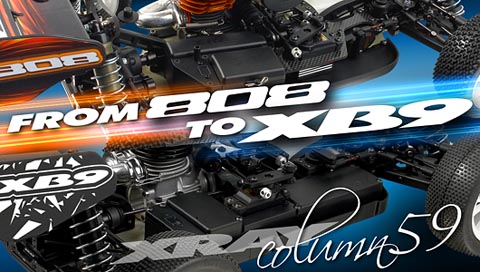
(click to enlarge) |
|
|
|
In the last column I provided you with some first insights behind the scenes of making the all-new XB9. There were so many things that I had no other chance than to split the story into two parts. This second part comes with a bit of a delay as the last several weeks were so busy especially with finishing the XB9.
Here we go with the rest⦠|
|
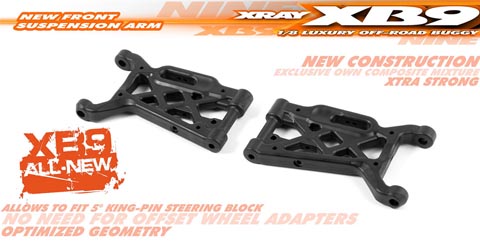
(click to enlarge) |
|
| Suspensions |
|
The correct and optimum suspension geometry and the flex of the suspension parts are of course very critical to the handling and performance of a car. For the XB9 we have used the same style and type of suspension which was well proven on the 808 platform, but of course a lot of testing and different prototypes were worked around. To test all the different ideas and improvement ideas that we had collected over the recent year from the team, we had to produce several different suspension holders, different arms, steering blocks and caster blocks and then try all the different combinations for more than a year. The first test was to compare short and long suspension arms and for this we made several different prototypes. The interesting thing was that the feedback from team driers was very different on the same parts; some preferred the short arms while some preferred the long arms. At one point I thought that the only solution would be to offer two different lengths of arms to allow team drivers to adjust the car to their specific needs and preference.
But then we realized that while this might work for team drivers, regular customers would be frustrated and just confused and would have more set-up troubles and problems. Of course we needed to offer the team drivers a very effective set-up feature, while on the other hand we needed to keep things simple for regular drivers. The goal was to make the car work the same in all conditions: European tracks that were fast but bumpy with long and fast corners, and also US-style tracks with big jumps, 180 degree corners and dusty surface. The long arms were working great on European-style tracks as the car is more stable and on the bumpy surface it is more forgiving and easier to drive. For the US-style tracks the rear shorter arms work better as the car is more reactive and rotates much better in 180 degree corners so at that end it is faster. The final result and feeling from all the drivers were the same: the short arms decrease traction which makes the car less stable in corners but allows it to rotate faster. |
|
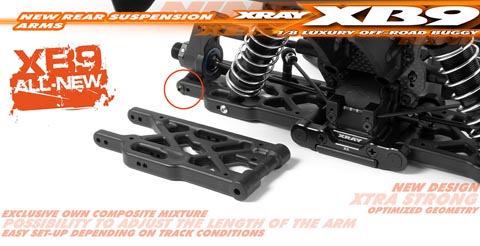
(click to enlarge) |
|
|
|
| For all the tests we made aluminum rear uprights with two holes and we added an extra hole into the long arm, so using the combination of the prototypes we could easily simulate the short and long arms by simply changing the suspension pin to a different hole position. This allowed us to keep the suspension holders the same but shortened the outer point of turning on the suspension arm where the rear hub is mounted. Of course from the perspective of roll centers this modification does not provide the same roll center âśfeelingâś but the handling of the car corresonds to the short and long arms respectively. All the prototype positions on the arms and uprights made it into the final XB9 as the benefits and very positive feedback were so big that I just could not ignore them and had to rework the suspension arm moulds to incorporate these new ideas and new set-up feature. When we already re-opened the mould for the suspension arms we also used this âśopportunityâś to change and optimize the shock positions on the suspension arms. |
|
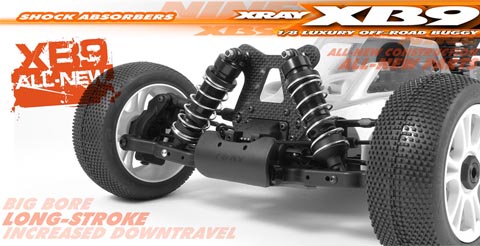
(click to enlarge) |
|
| Shocks |
|
There is always a lot of discussion around the shocks, about which are good or best in which conditions. At some point THESE shocks are best, the next time THOSE shocks are best, and each time something else about the track type and/or conditions differentiates them. The 2011 shocks on the 808 were seriously updated and improved, featuring an all new O-ring shape and material, all-new refined tolerances and improved details. To protect the shocks we used a protective shock rubber which was very thin and unfortunately used to break. To fix this problem we made the shock boot from thicker material but then the shockâ™s working was not as smooth as before or what we desired. For the XB9 I decided to completely redesign the shocks and analyze all the parts in the smallest details and to test and compare everything personally. To test the shocks and collect the feedback and data recorded from testing, I decided this time not only to make the track tests personally but to produce special testing and measuring equipment that would professionally test and analyze the workings of the shocks.
To make the car stable I needed to increase the volume of shocks without making the upper mounting position any higher because that would negatively influence the handling. As such I designed the shock to be the same size and length as the previous one but which has increased travel. The result is that the arms have better down-travel while the up-travel did not change. We have achieved this by increasing the working length and inner proportions. The inner diameter was increased to 16mm which also increased the volume of the oil inside the shock. |
|
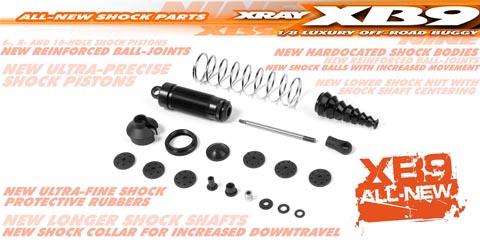
(click to enlarge) |
|
|
|
To fit the new shocks we had to produce an all-new mould for pistons. Proper shock adjustment is extremely important and as such the variety of all the different pistons has to be sufficient. As such 6, 8 and 10-hole pistons with different diameters were produced. There are always a lot of discussions around the shock pistons and a lot of comparisons about whether moulded or machined pistons are better; each type has their pros and cons. The positive (but also negative at the same time) of machined pistons is the fact that they are machined, which means if the manufacturer pays perfect attention to the tolerances then all the pistons should be same and have perfect roundness. However, if the manufacturer does not pay enough attention then it could easily happen that the dimension and roundness of the pistons may vary.
The positive of the moulded pistons is that they are always the same because of the mould; the negative of moulded pistons is that to achieve a perfectly oval piston out of the mould is extremely demanding. Why? Because every moulded part after it cools down shrinks and as such you cannot create a round mould because after the cool-down process they get oval. As such you need to have the knowledge and lots of experience to know how oval a mould you need to produce so the final piston gets perfectly round after it cools down. This is a real alchemy and extremely a time- and resource-demanding process and this is why almost all other companies use machined pistons.
Myself, I am convinced that when the piston is moulded from a perfectly-designed mould then all the edges, radius, holes, finish and everything is absolutely same on all the pistons and as such they are at least as good as machined if not better because they are all the same. The same theories say the machined pistons are better because they are produced from a bar material such as Delrin™. Well, the bar material had to be first moulded, so in the fact there is no difference between the material and Delrin™ (a brand name) and the composite mixtures XRAY has been using for its own composite mixture. To disclose a secret ⓠwe add a bit of Teflon™ inside our own mix to make the sliding characteristics of the piston even smoother. |
|
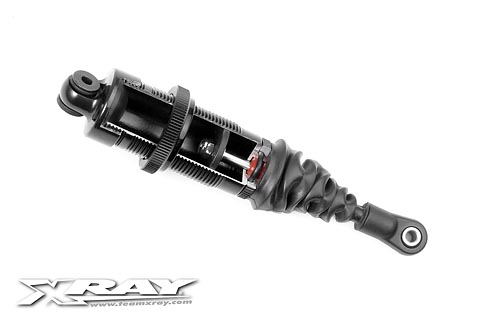
(click to enlarge) |
|
|
|
For the XB9 I decided to make an all-new mould and based on previous experiences we made it even better this time around. During the design process we incorporated the ovality that we expected but made the size of the piston a bit larger to incorporate corrections. After the first prototypes were produced from the mould we used a very special and ultra-precise digital measuring equipment to measure every small detail. From these we got these real figures and plugged them into the CAD software which calculated the corrections needed for the mould. We repeated this procedure a few times until we achieved absolute roundness. Now the precision of roundness of each piston is within 0.02mm!
The rest of the shock on the XB9 is almost entirely all-new, except for the upper ball joint and the adjustable lower collar everything else is completely new. All improvements were made based on feedback and reports, as well as based on personal experiences. Myself, I kept having problems that after big jumps I broke the front shock ball joint, and as such I completely reworked the lower mounting parts including the way the protective rubber boot is mounted. The previous protective rubber boot was also something that needed some significant change. Everything is new on the protective rubber boots â“ the design as well as the material. The previous rubber boot was limiting the up-travel and of course this had to be eliminated. The new design has the same accordion design but after it is compressed it does not influence the up-travel. For better compatibility, the front and rear boots are identical. I am convinced that the new shocks will make customers very happy with their performance, reliability, and ease of maintenance. |
|
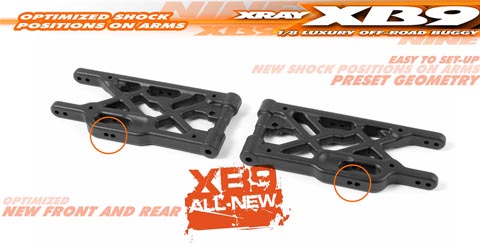
(click to enlarge) |
|
|
|
To identify the new shocks from the previous versions we decided on a black surface treatment. The shock bodies are still produced from the same premium-quality Swiss 7075 T6 and hardcoated for extra long life; only after that do we add the black surface coloring.
The other problems I used to experience with the previous car were the front upper shock mounting screws which would bend after big crashes. Sometimes I could easily stretch them back but sometimes they were so bent they could not be fixed or sometimes they even broke after a big crash. It was strange that nobody else complained about this during all these years, but since I was having trouble I am sure our customers must have experienced the same trouble, unless they crash a bit less than me. The new front upper shock mounting screw now has a new one-piece design and is machined from HUDY Spring Steel™. The new design eliminates the possibility of bending as well as making it much easier to change the shock positions on the shock tower. |
|
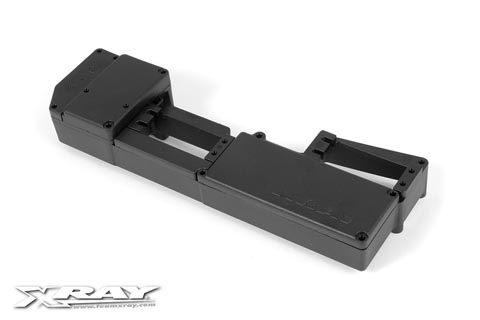
(click to enlarge) |
|
| Composites: |
|
I can honestly say that we at XRAY have some of the largest knowledge bases and experiences with composite parts. As mentioned in several columns, for every single part we use a very specific composite mixture and all of our mixtures are our own secret blending formulas. With every new product we produce samples of dozens of different mixtures, and all parts are tested both for mechanical and also performance purposes using our own self-developed testing machines as well as real track conditions. But with development never ending, there are always some new materials available on the market and of course we also have many new ideas for some new blending techniques or different mixtures.
With the XB9 we tested several new compounds which I was expecting should be an improvement. After several extensive tests my expectations were not realized and in the end for the XB9 we used well-proven compounds. At this time, with our knowledge and available materials on the market I am convinced that we have the best composites of any off-road car. Of course this may change tomorrow if some new materials are released or when I get another crazy idea to test this or that to see if there are any improvements. |
|
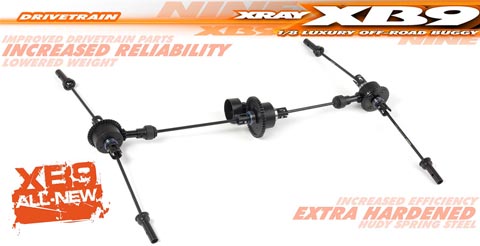
(click to enlarge) |
|
| Drivetrain: |
|
The drivetrain is very important on any racing car. Many times I get questioned by customers about why our drivetrain parts are so expensive. Well, there are several factors that influence this. First of all, all drivetrain parts are machined from HUDY Spring Steel™ which is our own secret formula material which is custom made. We do not use any standard cheap automotive steel that others use, but rather we use this very expensive custom-made material. Only when using this material we can achieve such extraordinary lifetime and strength. Of course not only is the raw material several times more expensive, but also its production is costly. To machine such high-strength material, the cutting speed on our machines has to be considerably slower which increases production time, the machine tools must be all special (which are extremely expensive) and the wear of the tools is much higher which requires more frequent tool exchanges and as such the machine set-up must be redone to ensure proper control.
Of course all these factors influence the price as well as the quantity of the products made. As our drive shafts last several times longer than any others, a typical customer needs only few spares (if any), while on the competitionâ™s cars the customer needs to replace the drive shafts much more frequently. So a typical competition customer consumes plenty of drive shafts per year while an XRAY customer usually lasts a very long time with the kit drive shafts. While the competition produces parts from cheap and soft materials, produces several times higher quantity, using cheap basic machines and tools, the price for their drive shafts is of course⦠cheap. So in the end, the XRAY drive shafts are not expensive, but rather they reflect the real value. |
|
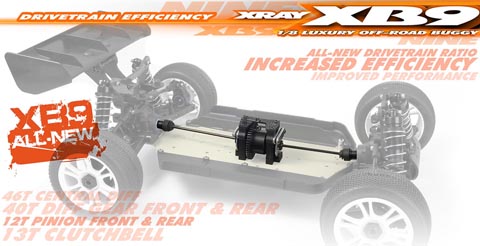
(click to enlarge) |
|
|
|
When designing the XB9 I wanted to eliminate the problems with the central drivetrain which we had experienced on the 808. The 808 used a direct connection of pinion into the driveshaft which was an all-new idea which worked well. To accommodate this large pinion we used large bearings and unfortunately those bearings required much more frequent servicing than the off-road customers are used to and therefore in those cases when customer did not regularly clean the bearings they used to become stuck, melt, and break⦠many times damaging the pinion. We wanted to solve this problem and as such for the 2011 version of 808 we returned to the XB8/XT8 drivetrain system which has no such problems. However, the central driveshaft had higher RPM and the angle of the driveshaft was larger than on XB8, the drive pins and coupling had higher wear rate when they were not lubricated properly.
To solve this matter completely I have changed the central drivetrain completely. We changed the drivetrain ratio so the central drive shaft has a lower RPM which also helps to balance the moment of the central differential and helps to balance the car in jumps. For the center diff we use 44-48T spur gear and 12-15T clutchbell. On the central driveshaft we use a larger 3mm pin and larger coupling without locking setscrew which increased the carrier area and the wear of pin gets more equal which eliminated the âścrankâť effect of the pin in the outdrive, which in turn decreases the wear of the outdrive. To help with the lifetime and reduce servicing, we added the rubber protective to prevent dust from getting into the assembly.
Over the last year we made a big improvement on the 1/8 off-road car platform and I am very satisfied with the result. I have focused on all the smallest details and especially the parts and areas which were reported by team drivers and public. I am convinced that the new XB9 platform will be our most successful off-road buggy⦠until we design an even BETTER one. |
|

|
See you around the tracks!
Enjoy the ride and â�til next time,
Dipl. Eng. Juraj Hudy
XRAY Chief Designer |
| Archive: |
|
Column #1 - Behind the Scene Stories
Column #2 - Worlds Flashback
Column #3 - T2'007 Debut
Column #4 - Designing the T2'007
Column #5 - Worldcup Review and NT1 Testing
Column #6 - Developing and Designing the NT1
Column #7 - Developing and Designing the NT1 - Part 2
Column #8 - Back to the Races
Column #9 - XT8 Truggy Development
Column #10 - Touring Car Development
Column #11 - Bling-bling Mentality
Column #12 - Hot Summer Washout
Column #13 - New Electric Touring Car
Column #14 - Off-road Development
Column #15 - My micro love
Column #16 - Back in the Dirt
Column #17 - Worlds Preparations
Column #18 - 808 Tests & Stress
Column #19 - Excited for the Worlds?
Column #20 - Statistics, Expenses Sheets, Production Analysis, Calculationsâ¦
Column #21 + Column #22 - Euros + Euros + Worlds
Column #23 - The Busiest Season Ever
Column #24 - In Between the Worlds
Column #25 + Column #26 - Well Developed or Overdeveloped?
Column #27 - Back to The Future
Column #28 - 2009 Kick-off
Column #29 - Crazy what?
Column #30 - Last indoor race of the season
Column #31 - Getting into summer season
Column #32 - Heading for the Euros
Column #33 - Testing - Always last minute, always new ideas
Column #34 - European Champion - title celebration
Column #35 - Time to move on
Column #36 - National Heroes
Column #37 - 2010 ready
Column #38 - Decade of Triumph
Column #39 - 2010 Racing Calendar
Column #40 - DHI, ETS & NĂĽrnberg Show
Column #41 - World Championship Practice
Column #42 - EC indoor, EC 1/12, Silverstate, LRP Masters, Neo
Column #43 - Nationals All Around
Column #44 - Warm Warm-ups, Challenging Challenges
Column #45 - Electric Touring Worlds 2010
Column #46 - Team XRAY - World Champion!!!
Column #47 - Summer Vacation, 30x USA Champion Title
Column #48 - T3 Saga Continues
Column #49 - RX8 â“ What? How? When?
Column #50 - The Making of the RX8 â“ Part II
Column #51 - Shake It, Baby, Shake It...
Column #52 - Racing Season â�11 Full Running
Column #53 - From On-road to Off-road
Column #54 - Testing and Once Again⦠Testing
Column #55 - Half of the EC Championships â“ Done!
Column #56 - Summer is Goneâ¦Euros are Done
Column #57 - Never-ending Development
Column #58 - From XB8 to XB9 |
|























